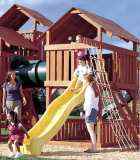An estimated 70 million homes across the USA claim outdoor wooden playsets, decks, and other structures that leach arsenic, sticking to children's skin and clothing at every touch. This results in substantial cancer risks faced by children who regularly play on CCA-treated wood.

While CCA manufacturers and the Environmental Protection Agency (EPA) had already agreed to phase out CCA treatment of wood for most consumer uses by the end of 2003 there are however many installations of such wooden structures existing. About 70% of existing U.S. single-family homes and 14% of public playgrounds incorporate CCA-treated wood.
For homeowners and others who want to reduce their potential arsenic exposure from their decks or other CCA-treated wood structures, new studies show that use, at least once a year, of an oil-or water-based, penetrating sealant or stain can reduce arsenic migrating from the treated wood. The data show that oil- or water-based sealants or stains that can penetrate wood surfaces are preferable to products such as paint, because paints and other film-formers can chip or flake, requiring scraping or sanding for removal, which can increase exposure to arsenic. Consumers should consider the required preparation steps (e.g., sanding, power washing, etc.) before selecting a product to minimize potential exposure to arsenic, both for initial application and re-coating.
 Related Studies
Related Studies
Elena Kwon, Hongquan Zhang, Zhongwen Wang, Gian S. Jhangri, Xiufen Lu, Nelson Fok, Stephan Gabos, Xing-Fang Li, and X. Chris Le,
Arsenic on the Hands of Children after Playing in Playgrounds, Environmental Health Perspectives Volume 112, Number 14, October 2004

Kristina M. Hatlelid, Patricia M. Bittner, Jonathan D. Midgett, Treye A. Thomas, Lori E. Saltzman,
Exposure and Risk Assessment for Arsenic from Chromated Copper Arsenate (CCA)-Treated Wood Playground Equipment, J. Child. Health, 2/3-4 (2004) 215-241.
DOI: 10.1080/15417060490930056

Mark S. Levenson, Treye A. Thomas, Warren K. Porter, David G. Cobb, Dwayne Davis, Jonathan D. Midgett, Lori E. Saltzman, Patricia M. Bittner,
A Field Study of Dislodgeable Arsenic from CCA-Treated Wood Using Human-Hand and Surrogate Wipes, J. Child. Health, 2/3-4 (2004) 197-213.
DOI: 10.1080/15417060490930074

Treye A. Thomas, Mark S. Levenson, David G. Cobb, Jonathan D. Midgett,
Warren K. Porter, Lori E. Saltzman, Patricia M. Bittner,
The
Development of a Standard Hand Method and Correlated Surrogate Method
for Sampling CCA (Pressure)-Treated Wood Surfaces for Chemical Residue, Journal of Children's Health, 2/3-4 (2004) 181-196.
DOI: 10.1080/15417060490930047

S.L. Shalat, H.M. Solo-Gabriele, L.E. Fleming, B.T. Buckley, K. Black, M. Jimenez, T. Shibata, M. Durbin, J. Graygo, W. Stephan, G. Van De Bogart,
A pilot study of children's exposure to CCA-treated wood from playground equipment, Sci. Total Environ., 367/1 (2006) 80-88.
DOI:10.1016/j.scitotenv.2006.01.002 Related Information
Related Information
 University of Wollongong, NSW, Australia: Treated Timber, Ticking Time-Bomb
University of Wollongong, NSW, Australia: Treated Timber, Ticking Time-Bomb Related News (newest first):
Related News (newest first):
 EVISA News, May 17, 2005: Arsenic in Pressure-Treated Lumber - Enhancing Childrens Cancer Risks
EVISA News, May 17, 2005: Arsenic in Pressure-Treated Lumber - Enhancing Childrens Cancer Risks EVISA News, March 19, 2005: Phasing out of chromated copper arsenate as a wood preservative
EVISA News, March 19, 2005: Phasing out of chromated copper arsenate as a wood preservative
last time modified: October 15, 2024